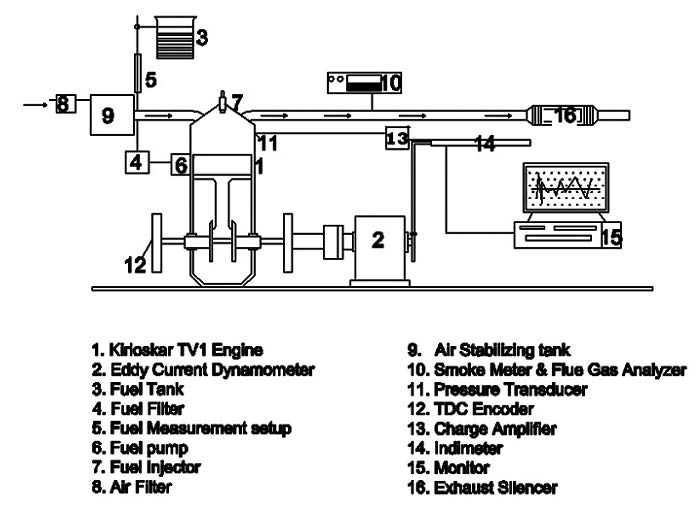- Ferrofluid,
- Nanofluid,
- Rice bran oil,
- Emissions
Copyright (c) 2018 Journal of the Chilean Chemical Society

This work is licensed under a Creative Commons Attribution-NonCommercial-ShareAlike 4.0 International License.
Abstract
Increase in NOx emission is one of the important drawbacks for using biodiesel as an alternative for petroleum diesel. Several studies had been carried out to reduce the NOx emissions level in biodiesel. The present work is the result of an attempt wherein ferrofluid is added to rice bran oil methyl ester in the way of analyzing its effects on emission characteristics. Magnetite concentrate is exothermic and is known for its characteristics of releasing copious heat at higher temperatures. Nanofluid using magnetite was synthesized by reacting Iron II (FeCl2) and Iron III (FeCl3) in an aqueous ammonia solution to form Magnetite Fe3O4 (Ferro fluid). Release of heat by magnetite during the combustion process would counterbalance the conventional limitations related with biodiesel such as increased delay period, inferior combustion rate and higher NOx emissions etc. Experiments were conducted with Rice Bran Oil Methyl Ester (RBOME) and Rice Bran Oil Methyl Ester with addition of ferrofluid (RBOMEF) and are compared with petroleum diesel. RBOMEF was prepared comprising 97.7% biodiesel, 2% magnetite based ferrofluid and 0.3 % surfactant by volume was used in a Compression Ignition engine. The experimental analysis found a decrease in HC, CO and NOx emissions of 10.8%, 9.1% and 8.49% respectively.

References
- MM. Roy, W. Wang, and J. Bujold, Biodiesel production and comparison of emissions of a DI diesel engine fueled by biodiesel–diesel and canola oil–diesel blends at high idling operations, Applied Energy, 106, 198–208, (2013).
- S MA. Rahman, HH. Masjuki, MA. Kalam, MJ. Abedin, A. Sanjid, and S. Imtenan, Effect of idling on fuel consumption and emissions of a diesel engine fueled by Jatropha biodiesel blends, Journal of Cleaner Production, 69, 208–215, (2014).
- S. Imtenan, HH. Masjuki, M. Varman, IM. Rizwanul Fattah, H. Sajjad, and MI. Arbab, Effect of n-butanol and diethyl ether as oxygenated additives on combustion–emission-performance characteristics of a multiple cylinder diesel engine fuelled with diesel–jatropha biodiesel blend, Energy Conversion and Management, 94, 84–94, (2015).
- K. Rajan, M. Prabhahar, and KR. Senthilkumar, Experimental studies on the performance, emission and combustion characteristics of a biodiesel-fuelled (Pongamia methyl ester) diesel engine with diethyl ether as an oxygenated fuel additive, International Journal of Ambient Energy, 1–7, (2014).
- J. Sadhik Basha and RB. Anand, Role of nanoadditive blended biodiesel emulsion fuel on the working characteristics of a diesel engine, Journal of Renewable and Sustainable Energy, 3, 2, 023106, (2011).
- V. Arul Mozhi Selvan, RB. Anand, and M. Udayakumar, Effect of Cerium Oxide Nanoparticles and Carbon Nanotubes as fuel-borne additives in Diesterol blends on the performance, combustion and emission characteristics of a variable compression ratio engine, Fuel, 130, 160– 167, (2014).
- MA. Lenin, MR. Swaminathan, and G. Kumaresan, Performance and emission characteristics of a DI diesel engine with a nanofuel additive, Fuel, 109, 362–365, (2013).
- GR. Kannan, R. Karvembu, and R. Anand, Effect of metal based additive on performance emission and combustion characteristics of diesel engine fuelled with biodiesel, Applied Energy, 88,11, 3694–3703, (2011).
- MB. Shafii, F. Daneshvar, N. Jahani, and K. Mobini, Effect of Ferrofluid on the Performance and Emission Patterns of a Four-Stroke Diesel Engine, Advances in Mechanical Engineering, 3, 529049–529049, (2011).
- H. Kim and B. Choi, The effect of biodiesel and bioethanol blended diesel fuel on nanoparticles and exhaust emissions from CRDI diesel engine, Renewable Energy, 35, 1, 157–163, (2010).
- Gagendeep singh, Rupinder singh, and Gurpreet Singh Batth, Utilization of Rice Bran Oil and Ethanol blend in a Single Cylinder DI Diesel Engine, International Journal of Emerging Science and Engineering, 1, 10, 25-28, (2013).
- CH. Narshima, and M.Rajesh, Performance and emissions characteristics of diesel engine fuelled with rice bran oil, International Journal of Engineering Trends and Technology, 4, 10, 4574-4578, (2013).
- R. Senthil kumar and R. Manimaran, Evaluation of a diesel engine using rice bran oil as a bio-diesel. International Journal of Science Engineering and Technology Research, 3, 6, 1779-1789, (2014).
- MR. Mitchell, RE. Link, MJ. Kao, CC.Ting, BF. Lin, and TT. Tsung, Aqueous Aluminum Nanofluid Combustion in Diesel Fuel. Journal of Testing and Evaluation, 36, 2, 100579, (2008).
- P. Berger, NB. Adelman, KJ. Beckman, DJ. Campbell, AB. Ellis, and GC. Lisensky, Preparation and Properties of an Aqueous Ferrofluid, Journal of Chemical Education, 76, 7, 943, (1999).
- PM. Patel, Effect of magnetic field on performance and emission of single cylinder four stroke diesel engine, IOSRJEN, 4, 5, 28–34, (2014).


